module 17 Evolution of Niches and Species Distributions
Because evolution alters the traits that species express and because different traits perform well in some environments but not in others, the evolution of species affects where species are able to live on Earth. As environments have changed over millions of years, species have responded by altering their distributions. This response also suggests that environmental changes in the future will continue to affect the distributions of species. Species that can move easily will likely persist whereas species that cannot adjust or move will likely go extinct.
169
Learning Objectives
After reading this module you should be able to
explain the difference between a fundamental and a realized niche.
describe how environmental change can alter species distributions.
discuss how environmental change can cause species extinctions.
Every species has a niche
Range of tolerance The limits to the abiotic conditions that a species can tolerate.
Fundamental niche The suite of abiotic conditions under which a species can survive, grow, and reproduce.

Every species has an optimal environment in which it performs particularly well. All species have a range of tolerance, or limits to the abiotic conditions they can tolerate, such as extremes of temperature, humidity, salinity, and pH. FIGURE 17.1 illustrates this concept using one environmental factor—
Realized niche The range of abiotic and biotic conditions under which a species actually lives.
Distribution Areas of the world in which a species lives.
The fundamental niche establishes the abiotic limits for the persistence of a species. However, biotic factors can further limit the locations where a species can live. Common biotic limitations include the presence of competitors, predators, and diseases. For example, even if abiotic conditions are favorable for a plant species in a particular location, other plant species may be better competitors for water and soil nutrients. Those competitors might prevent the species from growing in that environment. Similarly, even if a small rodent can tolerate the temperature and humidity of a tropical forest, a deadly rodent disease might prevent the species from persisting in the forest. Therefore, biotic factors further narrow the fundamental niche that a species actually uses. The range of abiotic and biotic conditions under which a species actually lives is called its realized niche. Once we determine what contributes to the realized niche of a species, we have a better understanding of the distribution of the species, or the areas of the world in which the species lives.
170
Niche generalist A species that can live under a wide range of abiotic or biotic conditions.
Niche specialist A species that is specialized to live in a specific habitat or to feed on a small group of species.
When we examine the realized niches of species in nature, we see that some species, known as niche generalists, can live under a very wide range of abiotic or biotic conditions. For example, some insects, such as the meadow spittlebug (Philaenus spumarius) (FIGURE 17.2a), feed on numerous plant species and can live in different habitats. Other species, known as niche specialists, are specialized to live under a very narrow range of conditions or feed on a small group of species. For example, the skeletonizing leaf beetle (Trirhabda virgata) (FIGURE 17.2b) feeds on only a single species or genus of plant. Niche specialists can persist quite well when environmental conditions remain relatively constant, but they are more vulnerable to extinction if conditions change because the loss of a favored habitat or food source leaves them with few alternatives for survival. In contrast, niche generalists should fare better under changing conditions because they have a number of alternative habitats and food sources available.
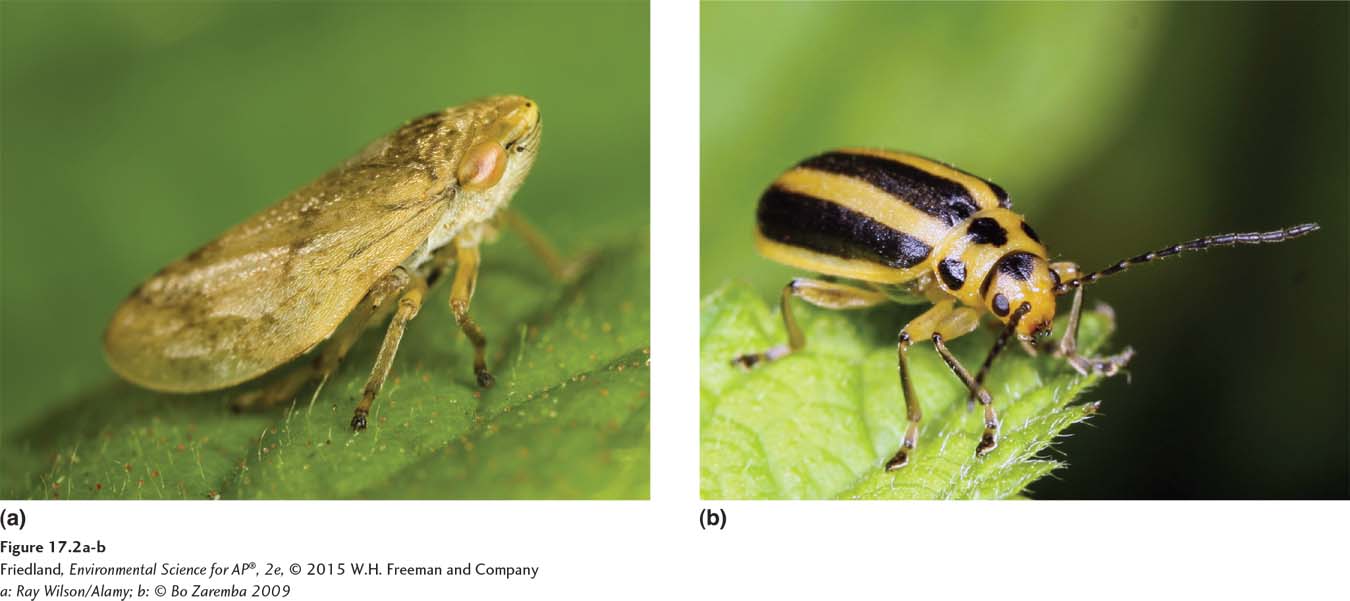
Environmental change can alter the distribution of species
Because species are adapted to particular environmental conditions, we would expect that changes in environmental conditions would alter the distribution of species on Earth. For example, scientists have found evidence for the relationship between environmental change and species distribution in layers of sediments that have accumulated over time at the bottom of modern lakes. Each sediment layer contains pollen from plants that lived in the region when the sediments were deposited. In some cases, this pollen record goes back thousands of years.
In much of northern North America, lakes formed 12,000 years ago at the end of the last ice age when temperatures warmed and the glaciers slowly retreated to the north. The retreating glaciers left behind a great deal of barren land, which was quickly colonized by plants, including trees. Some of the pollen produced by these trees fell into lakes and was buried in the lake sediments. Scientists can measure the ages of these sediment layers with carbon dating (see Chapter 2). Furthermore, because each tree species has uniquely shaped pollen, it is possible to determine when a particular tree species arrived near a particular lake and how the entire community of plant species changed over time. FIGURE 17.3 shows pollen records for three tree species in North America. These pollen records suggest that changes in climatic conditions after the ice age produced substantial changes in the distributions of plants over time. Pine trees, spruce trees, and birch trees all moved north with the retreat of the glaciers. As the plants moved north, the animals followed.
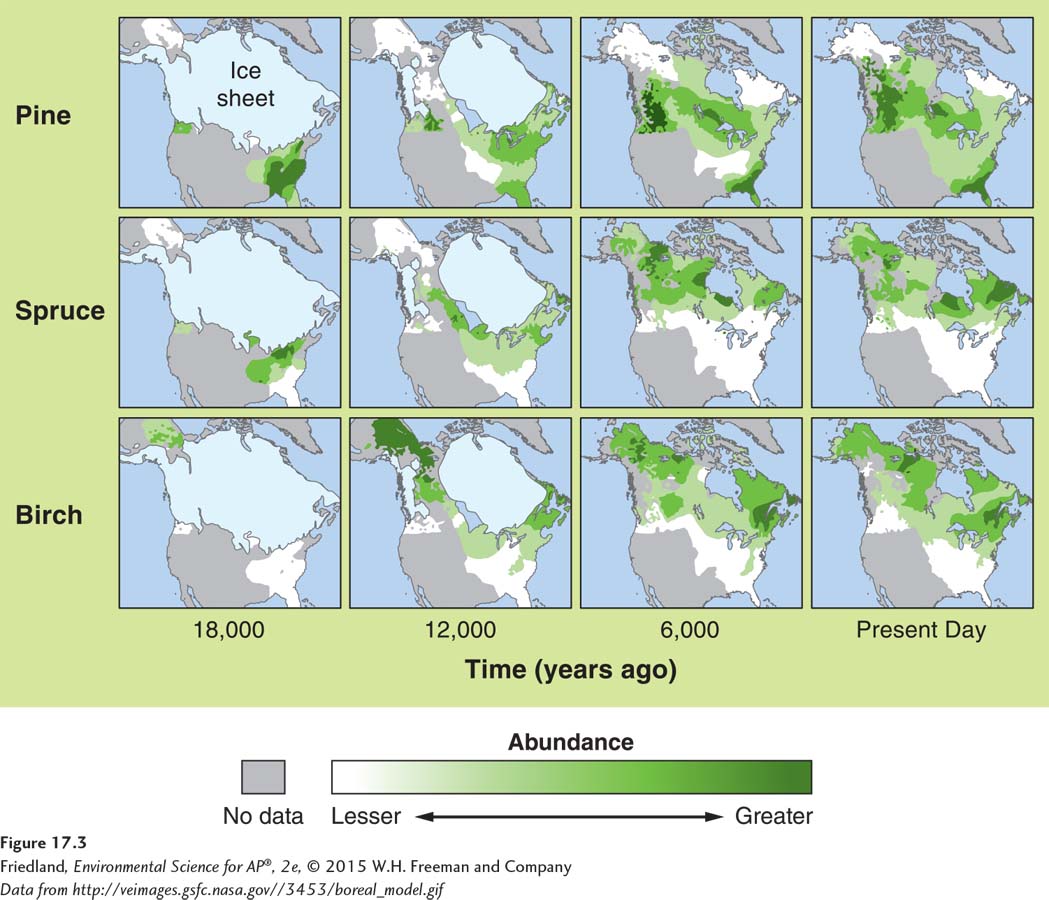
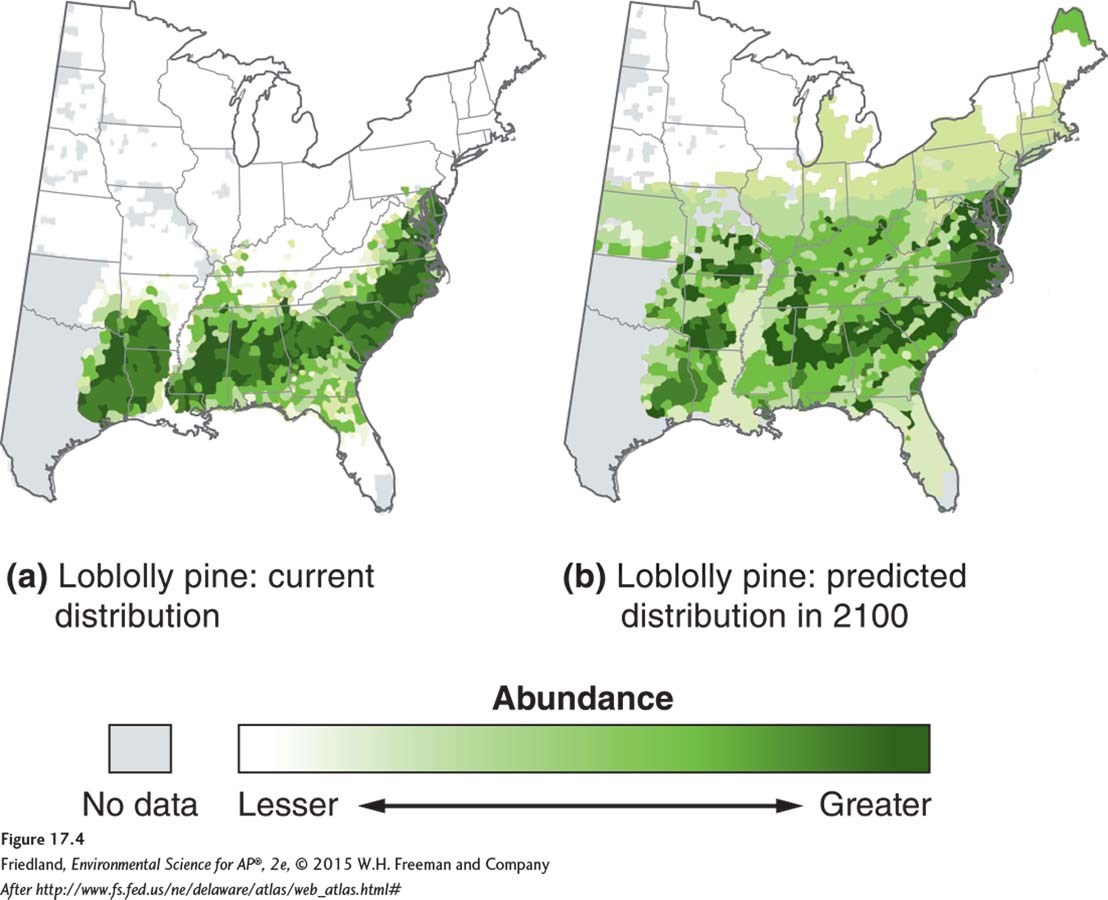
Because past changes in environmental conditions have led to changes in species distributions, it is reasonable to ask whether current and future changes in environmental conditions might also cause changes in species distributions. For example, as the global climate warms, some areas of the world are expected to receive less precipitation, while other areas are predicted to receive more. If our predictions of future environmental changes are correct, and if we have a good understanding of the niche requirements of many species, we should be able to predict how the distribution of species will change in the future. North American trees, for example, are expected to have more northerly distributions with future increases in global temperatures. As FIGURE 17.4 shows, the loblolly pine (Pinus taeda) is expected to move from its far southern distribution and become common throughout the eastern half of the United States.
171
Species vary in their ability to move physically across the landscape as the environment changes. Some species are highly mobile at particular life stages: Adult birds and wind-
Environmental change can cause species extinctions
If environmental conditions change, species that cannot adapt to the changes or move to more favorable environments will eventually go extinct. The average life span of a species appears to be only between about 1 million to 10 million years. In fact, 99 percent of the species that have ever lived on Earth are now extinct.
There are several reasons why species might go extinct. First, there may be no favorable environment close enough to which they can move. For example, on the southwest coast of Australia is a small area of land that experiences a current climate that supports a woodland/shrubland biome (see FIGURE 12.9 on page 128). This biome is surrounded by a large desert biome to the north and east and an ocean to the south and west. If scientists are right in predicting that the coming century will bring a hotter and drier climate to southwestern Australia, then the unique species of plants that live in this small biome will have nowhere to go where they can survive.
172
Even if there is an alternative favorable environment to which a species can move, it may already be occupied by other species against which the moving populations cannot successfully compete. For example, the predicted northern movement of the loblolly pine, shown in FIGURE 17.4b, might not happen if another pine tree species in the northern United States is a better competitor and prevents the loblolly pine from surviving in that area. Finally, an environmental change may occur so rapidly that the species does not have time to evolve new adaptations.
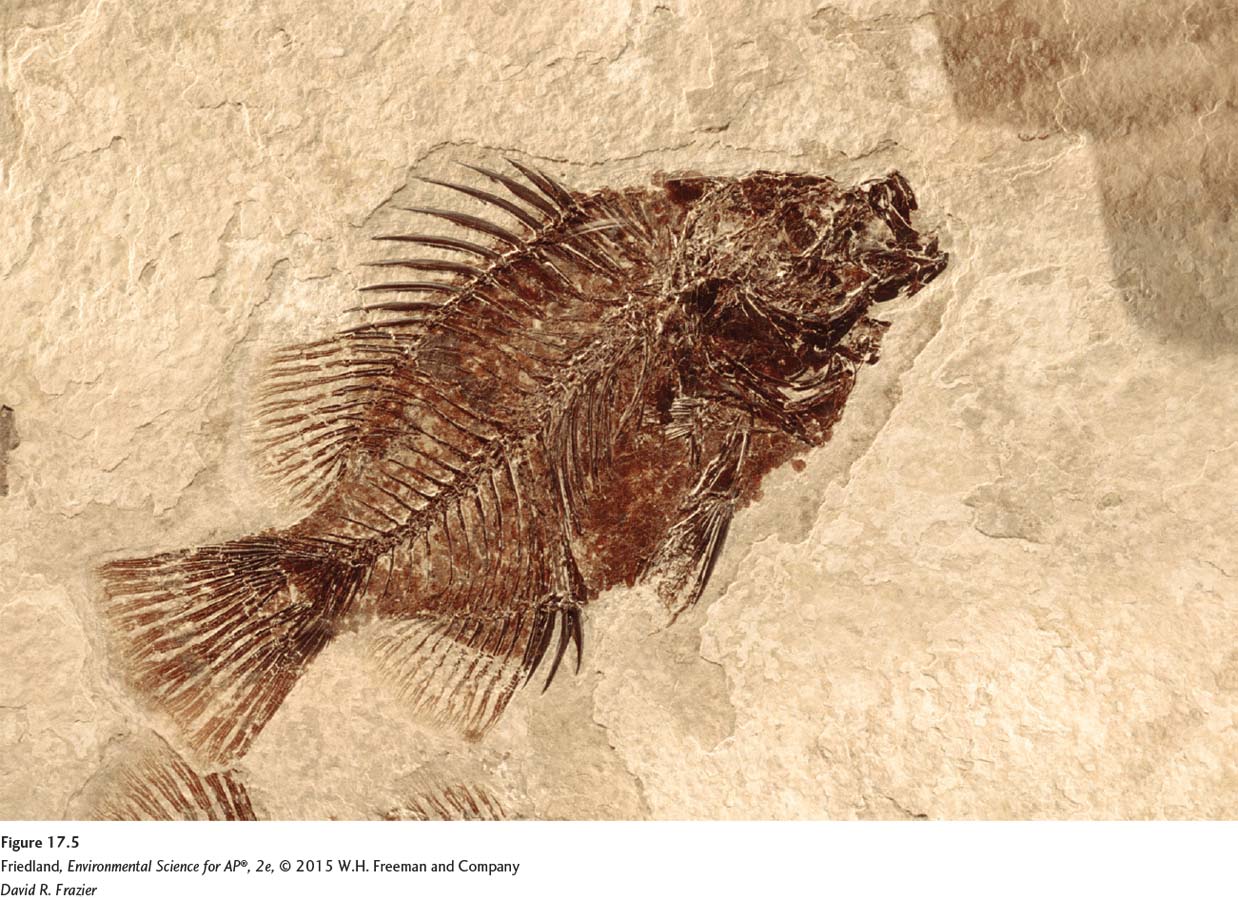
The Fossil Record
Much of what we know about the evolution of life is based on fossils, which are the remains of organisms that have been preserved in rock. Most dead organisms decompose rapidly; the elements they contain are recycled and nothing of the organism is preserved. Occasionally, though, organic material is buried and protected from decomposition by mud or other sediments. That material may eventually become fossilized, which means it has been hardened into rocklike material as it was buried under successive layers of sediment (FIGURE 17.5). When these layers are uncovered, they reveal a record of at least some of the organisms that existed at the time the sediments were deposited. Because of the way layers of sediment are deposited on top of one another over time, the oldest fossilized organisms are found in the deepest layers of the fossil record. We can therefore use the fossil record to determine when different species existed on Earth.
The Five Global Mass Extinctions
Mass extinction A large extinction of species in a relatively short period of time.
Throughout Earth’s history, individual species have evolved and gone extinct at random intervals. The fossil record has revealed five periods of global mass extinction, in which large numbers of species went extinct over relatively short periods of time. The times of these mass extinctions are shown in FIGURE 17.6. Note that because species are not always easy to discriminate in the fossil record, scientists count the number of genera, rather than species, that once roamed Earth but are now extinct.
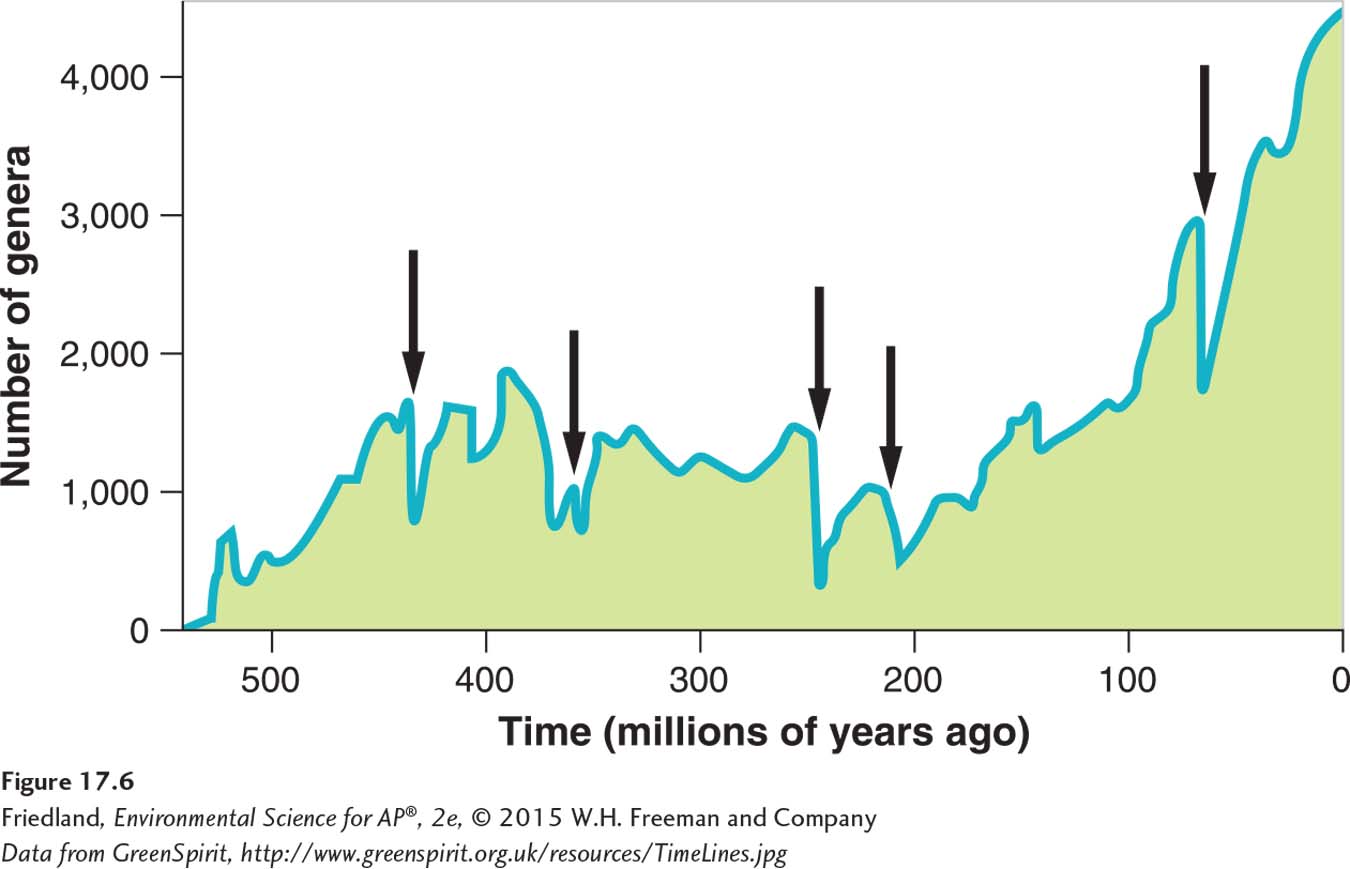
The greatest mass extinction on record took place 251 million years ago when roughly 90 percent of marine species and 70 percent of land vertebrates went extinct. The cause of this mass extinction is not known.
A better-
Many scientists view extinctions as the ultimate result of change in the environment. Environmental scientists can learn about the potential effects of both large and small environmental changes by studying historic environmental changes and applying the lessons learned to help predict the effects of the environmental changes that are taking place on Earth today.
173
The Sixth Mass Extinction
During the last 2 decades, scientists have reached a consensus that we are currently experiencing a sixth global mass extinction of a magnitude within the range of the previous five mass extinctions. Estimates of extinction rates vary widely, ranging from 2 percent to as many as 25 percent of species going extinct by 2020. However, in contrast to some previous mass extinctions, there is agreement among scientists that the current mass extinction has human causes. These wide-
The recovery of biodiversity from earlier mass extinctions took about 10 million years, an unthinkably long time from a human perspective. Recovery from the present mass extinction could take just as long—